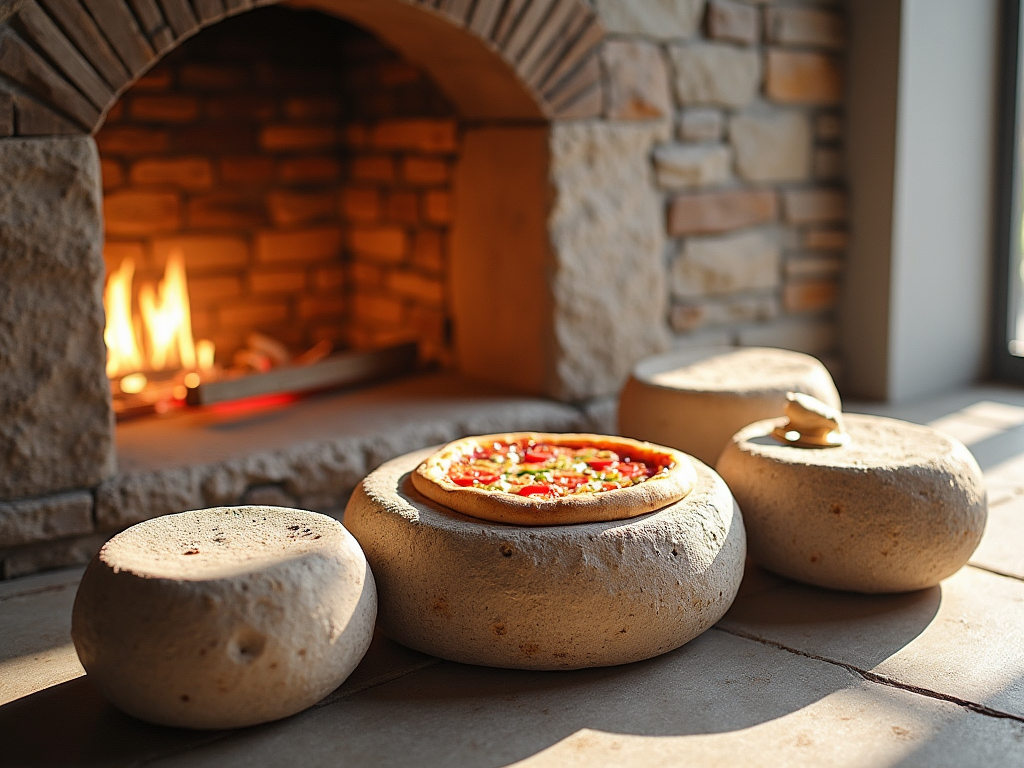Quick facts
Can't find the answer you're looking for? Please get in touch with our friendly team.
What not to do with a pizza stone?
Avoid soaking your pizza stone in water, as it can absorb moisture and crack when heated. Also, don’t use soap to clean it, as this can leave a residue that affects the flavor of your food. Lastly, don’t put a cold stone in a hot oven.
Do you put pizza dough directly on stone?
No, it's best to use a pizza peel or parchment paper to transfer the dough onto the stone. This prevents sticking and makes it easier to handle the dough. Always preheat the stone for optimal cooking results.
Why is my pizza stone flaking?
Your pizza stone may be flaking due to thermal shock from rapid temperature changes, or it could be made of a lower-quality material. To prevent this, avoid drastic temperature shifts and consider investing in a higher-quality stone designed for durability.
Is it worth buying a pizza stone?
Yes, a pizza stone is worth buying if you enjoy homemade pizza. It helps achieve a crispy crust by evenly distributing heat. Stones made of ceramic or cordierite are popular choices. Just remember to preheat the stone for the best results.
Do you need a pizza peel with a pizza stone?
While a pizza peel is not absolutely necessary, it is highly recommended when using a pizza stone. The peel allows you to easily transfer the pizza to and from the hot stone without burning yourself or damaging the pizza, ensuring a better cooking experience.
Why is my pizza sticking to my pizza stone?
Pizza may stick to the stone due to insufficient preheating, using too much moisture in the dough, or not using enough flour or cornmeal. Ensure the stone is hot before placing the pizza and lightly dust the surface to prevent sticking.
How long do I preheat my pizza stone?
Preheat your pizza stone for at least 30 minutes in the oven at a temperature of 475°F to 500°F (245°C to 260°C). This ensures the stone reaches the right temperature for a crispy crust when baking your pizza.
Can you put frozen pizza on a pizza stone?
Yes, you can put frozen pizza on a pizza stone. Preheat the stone in the oven before placing the pizza on it. This helps achieve a crispy crust. Cook according to the pizza's instructions, adjusting time if necessary to ensure even cooking.
How to use pizza stone in the oven?
To use a pizza stone, place it in a cold oven and preheat to the desired temperature, usually around 475°F (245°C). Once heated, carefully slide your pizza onto the stone using a pizza peel. Bake until the crust is golden, then remove and let cool before cleaning.
Should you oil a pizza stone?
No, you should not oil a pizza stone. Oiling can create smoke and affect the stone's ability to absorb moisture. Instead, clean it with a scraper and avoid using soap, as it can absorb flavors. Preheat the stone before placing the pizza on it.
What is the best stone to cook pizza on?
The best stone for cooking pizza is a pizza stone made of ceramic or cordierite. These materials retain heat well and distribute it evenly, resulting in a crispy crust. Make sure to preheat the stone in the oven for optimal cooking results.
Do pizza stones really work?
Yes, pizza stones work effectively by absorbing moisture and evenly distributing heat, resulting in a crispier crust. They help mimic the cooking conditions of a traditional pizza oven. To get the best results, preheat the stone in the oven for at least 30 minutes before baking.
Category Overview
Introduction
In the world of home cooking, pizza stones hold a special place. These essential tools transform your kitchen experience, allowing you to achieve that perfect crispy crust reminiscent of a wood-fired pizzeria. Beyond just utility, pizza stones enhance your everyday life by offering a reliable way to enjoy delicious homemade pizzas while promoting relaxation during gatherings with family and friends.
Functionality
Pizza stones serve several key functions. Primarily, they evenly distribute heat and absorb moisture, ensuring that your pizza cooks uniformly and develops that sought-after crunch. They can be utilized in various contexts—whether you’re baking in the kitchen or grilling outdoors. Some unique features may include a built-in handle for easy transport from oven to table or compatibility with different types of grills and ovens, making them versatile for any cooking enthusiast.
Design & Style
Most pizza stones are made from materials like cordierite, ceramic, or even stoneware. You might encounter variations such as round or rectangular designs tailored to different oven sizes and personal preferences. Depending on your decor style—be it rustic farmhouse or sleek modern—you can find pizza stones that seamlessly blend into your kitchen aesthetic. For those looking to personalize their space, consider choosing a stone with an attractive finish or one that fits harmoniously with your existing cookware.
Practical Considerations
When selecting the right pizza stone for your needs, consider factors like size, material durability, and cooking methods. Ensure it fits comfortably in your oven and is thick enough to withstand high temperatures without cracking. Avoid common pitfalls such as neglecting proper care instructions; preheating your stone correctly is crucial for optimal performance. By keeping these tips in mind, you can maximize not only functionality but also longevity.
Comparison and Alternatives
There are pros and cons associated with different materials used for pizza stones—cordierite is great for thermal shock resistance but may require more care than other options like ceramic. Round versus rectangular shapes offer their own advantages: round stones fit better within traditional ovens while rectangular ones provide versatility on the grill or when serving multiple pizzas at once. Ultimately, choose a design based on your cooking style and available space.
Trends and Popular Items
Currently, there’s a notable trend toward eco-friendly materials in the realm of kitchen tools—including pizza stones made from sustainably sourced materials. Additionally, artisanal designs featuring personalized engravings have gained popularity among home chefs looking to add character to their kitchen gadgets. Whether opting for traditional styles or exploring innovative options like cast iron alternatives, these trends reflect a growing appreciation for both aesthetics and sustainability in culinary experiences. By understanding how pizza stones function practically while considering design preferences and current trends, you can elevate not just your cooking game but also enhance the overall enjoyment you derive from creating delicious meals at home.


